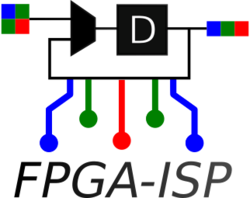FPGA Image Signal Processor - FPGA ISP Accelerators - Debayer
| FPGA Image Signal Processor |
|---|
 |
| Introduction |
| FPGA ISP Accelerators/Modules |
| Getting the Code |
| Examples |
| GStreamer Pipelines |
| Tested Platforms |
| Contact us |
Contents
Introduction
The FPGA-ISP Debayer Accelerator is an FPGA accelerator that performs image demosaicing captured in Bayer to RGB. One of the use cases is a Bayer camera connected to an embedded system, but this embedded system does not have an ISP or GPU. With this accelerator, you will easily integrate an accelerated demosaicing module in your platform without sacrificing any CPU resource.
Supported caps
The FPGA-ISP Debayer Accelerator is capable of managing the following image properties:
Input
Min resolution: 8x8 Max resolution: 4096x2160 Formats: RGGB, BGGR, GRBG, GBRG (8-bit bayer)
Output
Min resolution: 8x8 Max resolution: 4096x2160 (same as input) Formats: ARGB (32-bit format)
Algorithm overview
There are several ways to perform Bayer demosaicing. One of the most popular is a bilinear interpolation. In the FPGA-ISP Debayer Accelerator, the bilinear interpolation is transformed into a convolution of color kernels, based on the [1] approach. This makes the demosaicing much faster when combining this method with pixel streaming, saving area, and avoid any full memory copy into the FPGA, making this accelerator suitable to be implemented on FPGA without direct access to RAM.
Our accelerator is composed of a color filter (called Phi Filter), three convolutions, and a pixel joiner.
Additionally, the convolution kernels are represented in Qs(0,16) fixed-point representation, which guarantees the precision on the numeric computation of each channel and helps to save area as much as possible.
Example pipelines
In combination with RidgeRun's V4L2-FPGA, it is possible to create a V4L2 interface with GStreamer support, making even easier your computer vision application for embedded systems. Here are some example of pipelines to test the FPGA-ISP Debayer.
Generator (Accelerator input)
gst-launch-1.0 videotestsrc ! video/x-raw,format=ARGB,width=640,height=480 ! queue ! rgb2bayer ! "video/x-bayer,format=bggr" ! queue ! v4l2sink device=/dev/video2 -v
Sink (Accelerator output)
gst-launch-1.0 v4l2src device=/dev/video1 ! "video/x-raw, width=640, height=480,format=ARGB" ! perf ! videoconvert ! xvimagesink
Benchmarks
| Resolution | Maximum framerate (fps) |
|---|---|
| 4k | 7,464 |
| 1080p | 29,258 |
| 720p | 65,023 |
These framerates are taken based on the following setup:
System: NVidia Jetson Xavier FPGA: PicoEVB (Artix 7 XC7A50T CSG325 -2l) OS: Ubuntu 18.04 PCI-e: v2.0 - 1 lane
You can reproduce these results by using the following pipelines:
Generator (Accelerator input)
gst-launch-1.0 videotestsrc ! video/x-raw,format=ARGB,width=640,height=480 ! queue ! rgb2bayer ! "video/x-bayer,format=bggr" ! queue ! v4l2sink device=/dev/video2 -v
Sink (Accelerator output)
gst-launch-1.0 v4l2src device=/dev/video1 ! "video/x-raw, width=640, height=480,format=ARGB" ! perf ! fakesink sync=false
Known issues
1. GStreamer autonegotiation: The caps, such as width, height, and format, must be specified in the pipeline.